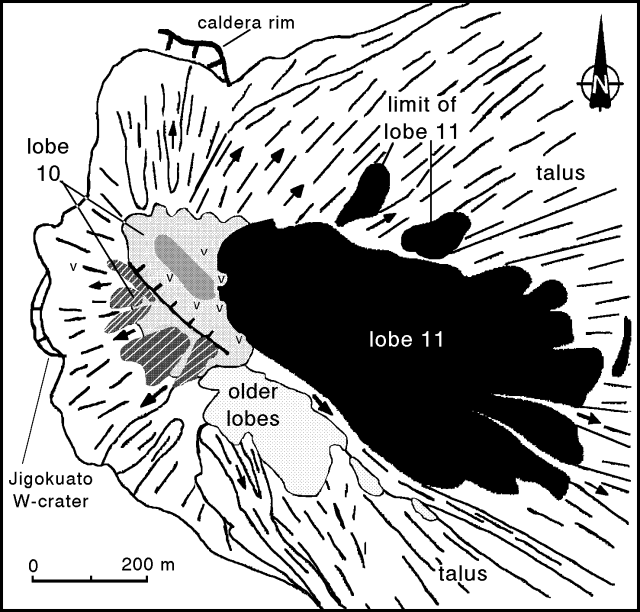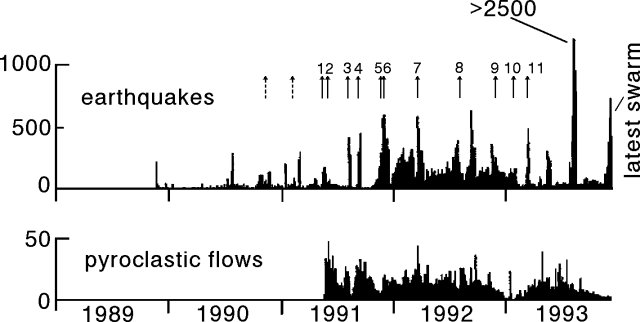Report on Unzendake (Japan) — November 1993
Bulletin of the Global Volcanism Network, vol. 18, no. 11 (November 1993)
Managing Editor: Richard Wunderman.
Unzendake (Japan) Only 32 pyroclastic flows, a seismic swarm, and remarkable dome inflation
Please cite this report as:
Global Volcanism Program, 1993. Report on Unzendake (Japan) (Wunderman, R., ed.). Bulletin of the Global Volcanism Network, 18:11. Smithsonian Institution. https://doi.org/10.5479/si.GVP.BGVN199311-282100
Unzendake
Japan
32.761°N, 130.299°E; summit elev. 1483 m
All times are local (unless otherwise noted)
For mid-November through the first week of December, dome building injections into lobe 11 mainly produced inflation, with no new material ejected to the lobe's surface. This purely inflationary (endogenous) dome growth contrasts with the pattern of exogenous growth typically seen at Unzen in earlier months. As a consequence, the measured inflation on the SW side of Jigoku-ato crater was the largest since May 1991. The previous vent area on lobe 11 underwent inflation, but elsewhere the dome surface changed little in form (figure 63).
In early- to mid-November inflation extended to an area on the W flanks of lobe 11 and also migrated to the northern portions of lobe 10 (figure 63). The SW limit of uplifted area on lobe 10 was confined by a normal fault (indicated by a hachured line). The SW portion of lobe 10 generated rockfalls, and small pyroclastic flows, and in this area radial cracks underwent extension. The N side of the uplifted area produced frequent rockfalls. The uplifted area has become the dominant zone for gas vents ("v", figure 63); earlier vents now lie covered and sealed beneath fresh talus deposits. An infrared camera survey was made by SEVO. They found the highest temperatures in the reddish uplifted lava blocks to the W of lobe 11.
Inflation caused the W sides of lobes 10 and 11 to exhibit remarkable structural changes: normal faults and simple cracks without previous noteworthy displacement opened as much as 1 m. These structural changes may have been somewhat local as they were not found on the NW portion of the dome. However, a GPS survey detected dome motion on the NW. Dome motion was larger on the W, and largest on the SW where it was estimated to be 50 cm/day. At latest report, the SW dome motion continued at the same rate from late November through mid-December, but the motion on the other flanks appears to have stopped.
Field inspection SW of the dome by the SEVO found multiple small-scale reverse faults in thick deposits of ash. These faults were of low angle and associated with pressure ridges, implying compression from the dome. Similar features were recognized this past April, located to the NW of the dome.
The present dome deformation was apparently not translated to the larger edifice; tiltmeters 5 km from the dome show angular stability. The present dome deformation episode is the third since lava extrusion began in May 1991. The first deformation began on 12 May 1991 and was followed by lava extrusion 8 days later. As of 13 December deformation continued, inferred to be centered beneath the dome.
Pyroclastic flows at Unzen are detected seismically. For 1993, they were most common in the interval from April-July (averaging 320 flows/month), and least common in November (32). They decreased in number presumably due to the comparatively static dome morphology. Traveling NE and E, the flows reached ~2.5 km in length. They were basically similar to those in October, although the heights of associated ash clouds may have been lower. The flows caused no damage, however, their potential hazard resulted in additional residents being evacuated in July 1993, bringing the total to 3,617.
Seismicity began to increase on 19 November, when 77 microearthquakes were recorded, up from an average of 20 events/day earlier in the month. The seismicity gradually increased to 400 events/day toward the end of the month (figure 64). By 13 December earthquakes rose to the level of a major swarm with 1,500 events/day. (Figure 64 does not show the December seismic data.) The monthly total rose from 1,101 events in October to 2,662 events in November. During November through mid-December typical earthquakes were dominantly composed of high-frequency signals. In contrast, past swarms within and beneath the dome were dominantly composed of low-frequency signals.
Geological Summary. The massive Unzendake volcanic complex comprises much of the Shimabara Peninsula east of the city of Nagasaki. An E-W graben, 30-40 km long, extends across the peninsula. Three large stratovolcanoes with complex structures, Kinugasa on the north, Fugen-dake at the east-center, and Kusenbu on the south, form topographic highs on the broad peninsula. Fugendake and Mayuyama volcanoes in the east-central portion of the andesitic-to-dacitic volcanic complex have been active during the Holocene. The Mayuyama lava dome complex, located along the eastern coast west of Shimabara City, formed about 4000 years ago and was the source of a devastating 1792 CE debris avalanche and tsunami. Historical eruptive activity has been restricted to the summit and flanks of Fugendake. The latest activity during 1990-95 formed a lava dome at the summit, accompanied by pyroclastic flows that caused fatalities and damaged populated areas near Shimabara City.
Information Contacts: JMA; S. Nakada, Kyushu Univ.



